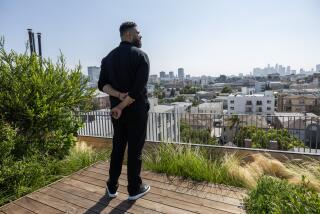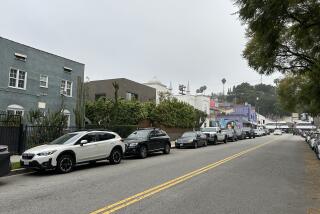Return of the Westside lefty
- Share via
Bill Rosendahl wants U.S. troops out of Iraq. No surprise there; in this overwhelmingly Democratic city, opposition to Bush administration policy of any kind is almost a given, and there’s not much political risk to a Los Angeles city councilman in introducing a resolution calling for troop withdrawal. That’s got to be especially true in Rosendahl’s Westside district, which includes some of the most archetypically L.A. parts of Los Angeles, such as Pacific Palisades and Venice. The fact that a city council (even the nation’s best-paid) has no official say in foreign policy is beside the point. An antiwar resolution is smart politics on a council whose members like to present themselves as progressive. Getting colleagues to sign on to this no-brainer was a snap; six wanted to be listed with Rosendahl as co-authors.
So it would go the same way, you might think, on any motion that allows members to fly their liberal colors. Take an issue like development. Stick up for the environment, or for rent control, over the interests of builders and large property owners -- in places, say, like the controversial 21st century Playa Vista development near Ballona Creek, or the rent-controlled 1950s Lincoln Place Garden Apartmentscomplex in California”>Venice -- and the rest of the council will line up behind you. Right?
Not right. Liberal comes in a variety of colors, and the council majority has picked out a shade that nicely complements the traditional cut of Los Angeles’ real estate industry. If you want to get elected in this town you need money, and that usually means keeping Big Labor and Big Development simultaneously happy. If you can keep single-family neighborhoods happy at the same time, you’re a political superstar.
Rookies may try to add their own flair, with fashions like inclusionary zoning. But they never seem to be able to pull it together. They generally drift into the prevailing pragmatic-left model of Los Angeles development -- the one that ends up with projects on the ground rather than lawyers in the courtroom. It goes pretty much like this: Let builders build moreapartments or condos on the site than zoning previously allowed, as long as some of those additional units will be sold, or rented, at below-market rate. Relieve builders of the requirement to give up valuable land to residential parking. Claim that the more densely packed residents who have no place to park their cars will be served by buses or light-rail because the new developments are on transit corridors. Agree that construction workers, and any employees in attached commercial projects, will be paid union-level wages. Now you’re in business.
Council members can then say, “See? We’re giving you union jobs, profitable development, some affordable (and plenty of profitable market-rate) housing, transit-oriented development.” That’s often enough, during campaign season, to get union workers to walk precincts and developers to fork over hefty donations.
Everyone gets the concept. They squabble over the details, like whether to carry over rent control to new developments after older, controlled buildings were demolished. But they agree on the general template.
Then along comes another rookie, who just has to try things his own way. Like Rosendahl.
The tall, imposing (and constantly smiling) former cable TV public affairs host became the 15-member council’s only newcomer when elected in 2005 after campaigning, in part, on protecting Lincoln Place tenants from eviction, and on guaranteeing environmental mitigation, at least, at Playa Vista. Voters in the district embraced his populist call for curbing development in pockets like Playa del Rey’s Toes Beach, fighting expansion of Los Angeles International Airport, preserving 1950s apartments for their historical value (and for affordable housing), and bringing light-rail to the area.
Others were skeptical. After having interviewed nearly everyone in town on his Adelphia program, he had to know how impractical his ideas were. He couldn’t really believe he could just “get everyone to sit down at the table and work it all out.” And he didn’t seem to grasp the whole pragmatic-left matchmaking between labor and developers. The Times editorial page called him “bombastic, divisive and ill-informed.” At the LA Weekly, where I was at the time, we complained that he discussed problems in “broad generalities,” making him a good populist orator but a less-than-ideal problem solver.
Besides, the City Council had been grappling with Lincoln Place and Playa Vista for years, and had resolved both issues with the standard pragmatic-left development accord. At Lincoln Place, a Venice apartment complex with 795 apartments in 52 buildings in a garden setting, the city took its own sweet time approving a plan to demolish the existing apartments and replace them with 654 market-rate condos, 52 “moderate-income” townhomes and 144 low-income apartments. The council got the then-property owner -- predecessor to current owner AIMCO Venezia LLC, a subsidiary of the mammoth Denver-based Apartment and Investment Management Company -- to agree to keep tenants, at the same rent, on the property in equal or better housing.
The new project would have all the goodies -- some affordable housing, location near a transit corridor, the works. It was to be the model answer to L.A.’s ills. Advocates for tenants of Lincoln Place noted that their existing complex seemed to fit all those criteria, and failed only in giving the owner as much income as it could get with a newer project. But the point was that it was AIMCO’s land, and AIMCO wanted to develop.
At Playa Vista, owned by Playa Capital Company, LLC, the council had weathered years of lawsuits by environmentalists who alleged that the site was environmentally sensitive, held sacred Native American artifacts, and hid dangerous pockets of methane. A first phase was built, and the council finally signed off on an environmental impact report for Phase II, reaching the standard political/development understanding. Playa Vista would be, after all, the model answer to L.A.’s ills -- some affordable housing, protection of greenspace, smart growth. Both projects were done deals. It was too late for Rosendahl, the new kid on the block, to do anything about them.
Yet he persisted. He criticized city lawyers for their counsel. He grew exasperated at his council colleagues for supporting the developers. He insisted that the city enforce a relocation agreement signed by the property’s previous owner (the city attorney said it couldn’t be done, since the agreement was never recorded). He complained, repeatedly, when builders asserted that preserving old units or protecting tenants didn’t pencil out. “Get a new pencil,” Rosendahl kept saying from the council floor.
He lost one vote after another on Lincoln Place and Playa Vista, as his colleagues pressed forward with both projects. 12-1. 13-1. 14-1. The courts backed the council. It was over.
Until two Thursdays ago. On Sept. 13, California’s Second District Court of Appeal reversed in the Playa Vista case, ruling that an environmental impact report was deficient in its analysis of the project’s effect on land use, archeology and wastewater. The court ordered an immediate halt to construction of Phase II. Activists -- who have argued for years that it makes no sense to build on the floodplain of what, after all, was once the bed of the Los Angeles River -- were reinvigorated.
A week later, a different panel of the same court reversed on Lincoln Place. Only 13 of the nearly 800 apartments are still occupied. But the court ordered a halt to eviction proceedings against those tenants.
Rosendahl, at least for the present, has been vindicated.
“I’m grateful,” he said, “that my instincts and my values have been ratified by the court.”
What now becomes of Los Angeles’ pragmatic-left model of development? Elected officials who tout their progressive credentials may find themselves wondering whether Rosendahl’s populist approach was a politically viable one all along. “You never go wrong when you support the people,” he said. Many of his council colleagues -- all of whom voted against him -- have congratulated him on the two rulings.
But no new apartments will magically appear in Los Angeles without developers, who complain bitterly that the city remains an unaffordable place to live because its leaders and its laws make it too hard to construct new housing here. The pragmatic-left model cut through all that.
Still: what is the new model of development really bringing the city? Is it just a fig-leaf for the same old political game of builders and politicians pursuing complementary interests so that both sets of pockets can be lined? So many of the new projects are, well, not to put to fine a point on it, ugly. The city is more densely packed, traffic is worse. The quality of life once enjoyed in a place like, say, Lincoln Place, is getting harder to attain for those without riches.
Rosendahl insists he is simply trying to keep his middle-class and working-class constituents housed. AIMCO and Playa Capital insist they are trying to house them, if only the city would let them.
Rosendahl’s solution for Lincoln Place sounds like something out of a Middle East negotiation. He wants a “right of return” for tenants who left. He said he can get it.
“We just need to get everyone to sit down at the table and work it out,” he said.
Robert Greene is a member of The Times’ editorial board; click here to read his archive. Send us your thoughts at [email protected].
More to Read
A cure for the common opinion
Get thought-provoking perspectives with our weekly newsletter.
You may occasionally receive promotional content from the Los Angeles Times.











